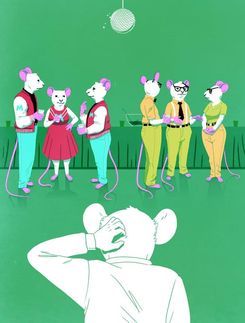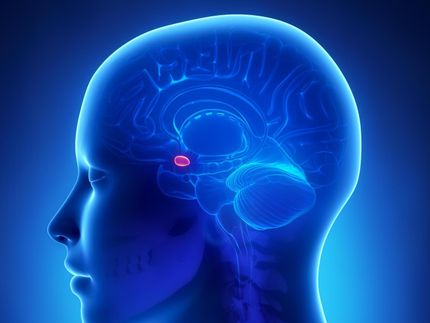“Star Wars therapy” for adolescents on autism spectrum
Mind power: Improvements without medication
Advertisement
Master Yoda can move objects with the power of his mind. Researchers are using young people’s fascination with Star Wars to get them interested in new treatment methods. A clinical study proves that young people on the autism spectrum can also learn to regulate their brain activity in the prefrontal cortex with the help of neurofeedback training. Regulating emotions and social behavior are some of the things this area of the brain is involved in.
Popular culture shapes the public image of people on the autism spectrum. But not all of them have a brilliant insular talent that makes them luminaries of casino gambling or the scientific community, like Raymond Babbitt, the lead character in the movie Rain Man, or Sheldon from the series The Big Bang Theory. Nor does autism affect only men. “The ratio of men to women with autism spectrum disorder (ASD) is four to one,” notes neuroscientist Lilian Konicar, dispelling a stereotype. Since 2017, Konicar has been in charge of the ABC BRAIN LAB at the University Department of Child and Adolescent Psychiatry at the Medical University of Vienna. The lab focuses on taking a holistic look at behavior, emotions and thoughts and applying scientific findings to clinical practice. Results from a randomized controlled trial of neurofeedback therapy, which was funded by the Austrian Science Fund FWF, show that adolescents with autism spectrum disorder can learn to volitionally change the activity level of their brain.
Owing to the lack of clinical trials involving young people – or women – medication in autism therapy is mostly used off-label, i.e. without having been approved for this purpose. Behavioral therapy is another approach, and it has proven helpful. The ABC BRAIN LAB has now conducted a clinical trial that relied on EEG neurofeedback to kindle self-efficacy. A total of 20 individuals with an ASD diagnosis between the ages of 12 and 18 underwent intensive neurofeedback training to help them self-regulate activity in the prefrontal cortex. This is the brain region where sensory input converges and where appropriate reactions are weighed and emotions are regulated. A 20-head control group was treated according to conventional clinical standards.
Autism has many faces
The term “spectrum” already indicates that autism spectrum disorder can involve a wide range of symptoms. Clinical diagnosis is complex and based on structured behavioral observation and interviews with the patients and their environment. Typical symptoms are severe deficits in social interaction because the individuals do not comprehend social context information. Lilian Konicar: “Irony, smirks, winks – in short everything that is conveyed between the lines of what is actually said, is something autists do not understood in the conventional sense (or take to mean something different). This severely limits coordinated communication, although some autists are able to learn this like a difficult foreign language.”
ASD is often accompanied by repetitive and ritualized behavior, as well as sensory hypersensitivity or hyposensitivity. Many people on the spectrum have a hard time coping with new situations and are known to adhere to regular behavior patterns and unchanging regularities. Currently, one in 88 children is diagnosed with ASD. Help that comes early is twice as effective, as the saying goes, and this is also true for ASD: a solid clinical diagnosis and coordinated treatment can prevent symptoms from becoming firmly entrenched.
Mind power
The new therapy on offer also involves a flavor of pop culture: the Star Wars universe and the mental capabilities supplied by “the Force” help the ABC BRAIN LAB team to communicate the treatment method to the young clients: “Most of them like the idea of mind power. We guide them through an intensive but simply designed neurofeedback program, provide encouragement and take measurements,” Konicar explains. The experimental therapy consisted of 24 sessions, divided into two blocks of 12 sessions each. The first block entailed two sessions a week, followed by a break during which participants can keep a diary for independent training in everyday life, and the second another 12 sessions of accompanied neurofeedback training.
With only a few electrodes – a regular EEG hood can be particularly uncomfortable for these adolescents – the brain waves in the prefrontal cortex were recorded, amplified and played back as a picture. The young people were then asked to try and make a fish on their screen swim up or down. The upward or downward movement represented the corresponding activation or downregulation of brain activity in the target area. Data to assess outcome were collected at three levels: subjective, physiological, and behavioral. The adolescents and their parents were interviewed several times about their subjective well-being. The change in brain waves was measured by means of functional and structural magnetic resonance as well as an at-rest EEG before and after treatment, and emotional and cognitive reactions were tested in a standardized computer test.
Improvements without medication
“As a neuroscientist, I’m very interested in physiological and behavioral changes, but the most important thing is the individual sense of well-being,” says principal investigator Konicar. The experimental group showed consistent improvements in the respective core symptoms, with measurable changes in social communication and behavior. This could be explained by the fact that regulating brain activity in the prefrontal cortex helps people better understand others and can also help them better regulate behavioral problems. “We provide an initial impetus with our devices, but, as with any therapy, the goal is to slowly phase out the input. And we were able to show in accompanying experiments that both female and male adolescents respond to it,” notes Konicar. The mind-power training is very beneficial, because the approach is non-invasive and does not require medication. The outcome of the project now provides scientific evidence that neurotherapy with EEG-based neurofeedback has a promising future, especially for young patients with autism spectrum disorder.





























































